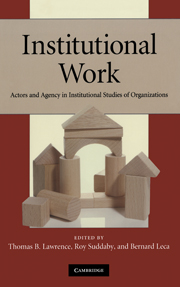Book contents
- Frontmatter
- Contents
- List of figures
- List of tables
- List of contributors
- 1 Introduction: theorizing and studying institutional work
- Part I Essays on institutional work
- Part II Studies of institutional work
- 6 Building the iron cage: institutional creation work in the context of competing proto-institutions
- 7 Scandinavian institutionalism – a case of institutional work
- 8 Institutional maintenance as narrative acts
- 9 Maintaining an institution in a contested organizational field: the work of the AACSB and its constituents
- 10 Institutional “dirty” work: preserving institutions through strategic decoupling
- 11 Doing which work? A practice approach to institutional pluralism
- Index
- References
9 - Maintaining an institution in a contested organizational field: the work of the AACSB and its constituents
Published online by Cambridge University Press: 15 September 2009
- Frontmatter
- Contents
- List of figures
- List of tables
- List of contributors
- 1 Introduction: theorizing and studying institutional work
- Part I Essays on institutional work
- Part II Studies of institutional work
- 6 Building the iron cage: institutional creation work in the context of competing proto-institutions
- 7 Scandinavian institutionalism – a case of institutional work
- 8 Institutional maintenance as narrative acts
- 9 Maintaining an institution in a contested organizational field: the work of the AACSB and its constituents
- 10 Institutional “dirty” work: preserving institutions through strategic decoupling
- 11 Doing which work? A practice approach to institutional pluralism
- Index
- References
Summary
The concept of institutional work (Lawrence & Suddaby, 2006) offers an important new way to frame institutional analysis, connecting disparate (at least in the empirical literature) institutional processes such as creating, maintaining, and disrupting institutions. With its focus on practical action within organizational fields, institutional work is concerned with the status of the institution itself, rather than simply the impact of institutions on other actors in an organizational field (Lawrence & Suddaby, 2006). We contribute to the study of institutional work by theoretically and empirically examining the question of how an institution maintains its impact on an organizational field in the face of change and the emergence of alternative mechanisms for structuring a field. As such, we are working with a case of institutional work that Battilana and D'Aunno (this volume) describe as practical-evaluative agency aimed at maintaining institutions. Specifically, we examine this in the context of legitimating organizations – organizations such as accrediting bodies, regulatory organizations, and governance associations – established to maintain particular institutional arrangements.
Individuals and organizations play an important role in organizational fields and the ongoing reproduction of institutions (Berger & Luckmann, 1966). Legitimating organizations maintain particular institutional arrangements by conferring legitimacy on other social actors and establishing mechanisms of compliance and membership (e.g. Lawrence, 2004). Although institutions represent a mechanism through which new processes, actors, and organizational forms can be integrated into a field (Greenwood, Suddaby & Hinings, 2002), legitimating organizations are often the public vehicle and symbolic touchstone for these institutional processes.
- Type
- Chapter
- Information
- Institutional WorkActors and Agency in Institutional Studies of Organizations, pp. 236 - 261Publisher: Cambridge University PressPrint publication year: 2009
References
- 48
- Cited by

